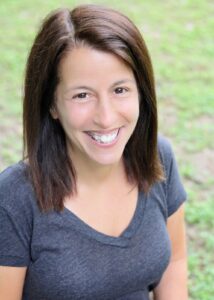 We’re closing out the year with Audrey Vernick, who’s the author of numerous picture books (including some that we’ve showcased here at OPB). She’s a prolific kidlit collaborator, too, having coauthored four picture books with Liz Garton Scanlon and two middle-grade novels with Olugbemisola Rhuday-Perkovich.
We’re closing out the year with Audrey Vernick, who’s the author of numerous picture books (including some that we’ve showcased here at OPB). She’s a prolific kidlit collaborator, too, having coauthored four picture books with Liz Garton Scanlon and two middle-grade novels with Olugbemisola Rhuday-Perkovich.
Audrey’s also a dog person. As a child, she had a “not very bright small white dog,” and these days, she lives in New Jersey with her family and a “medium-sized fairly smart black dog.” She also writes about dogs and other animals, too. Like buffalos!
And perhaps most important, Audrey—who grew up in Queens—is a big-time NY Yankees fan. Go, Yanks!!!
With that, let’s jump ahead to the interview so we can learn more about her.
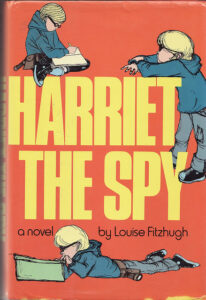 RVC: Rumor has it you were a huge fan of Harriet the Spy. True fact or an apocryphal story?
RVC: Rumor has it you were a huge fan of Harriet the Spy. True fact or an apocryphal story?
AV: True, and my love and respect for the text grew as I got older. I absolutely love how imperfect she is.
RVC: I was a Harriet fan, too. She’s awesome! Now, prior to getting an MFA in creative writing from Sarah Lawrence College, what did you think you were going to do for a living?
AV: Well, this is both prior and post, because I didn’t really expect the MFA to boost my employment opportunities. (And I was ever so right about that.) My last two jobs were writing periodicals for schools and libraries, and I wrote literary short fiction on the side. Opportunities to practice and improve your writing are always worthwhile and I thought I’d likely continue on with the work I was doing.
RVC: Long ago, I recall an interview where you talked about how challenging it is to understand—let alone use—a writing voice. This was specifically in relation to your Buffalo series, I think. What’s your relationship to writing voice today?
AV: This is a very annoying answer, so I apologize for that. Voice has always been the thing I have the least trouble with. It is almost always there. (I struggle mightily with plot.) And if voice is not there, that’s a pretty good hint to me that I have a lot I still need to figure out.
RVC: So it’s a warning sign then. Okay.
AV: With the Buffalo books, I remember learning how to get out of my own way. I realized I didn’t need to answer questions that really didn’t need answering, though they are sometimes called out when I’m meeting with young readers. Like how did that Buffalo get through the kindergarten classroom door? Wouldn’t Buffalo break the desks and chairs?
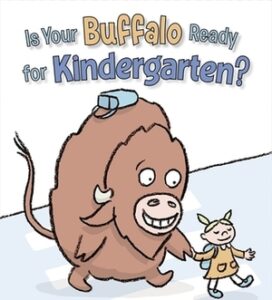 RVC: So, Is Your Buffalo Ready for Kindergarten? was your first picture book published with a major house. What’s the story behind that story?
RVC: So, Is Your Buffalo Ready for Kindergarten? was your first picture book published with a major house. What’s the story behind that story?
AV: My first agent represented primarily adult fiction writers. At the time I signed with her, I was writing fiction for both young readers and for adults. I was the one who had knowledge about the children’s market, and I pretty much had to direct her regarding who to submit to, etc. It wasn’t ideal, but I was getting read much faster than I had been when I did not have representation. When she was ready to part ways with me, I wanted to cling to her. But practically instantaneously upon signing with an agent with good relationships of her own within the market for which I was writing, something shifted in me. My writing became so much freer now that it wasn’t also my job to figure out where to submit, who required exclusives, etc. I’m not wildly self-aware, but I remember thinking, wow. Look at that.
RVC: What was the biggest lesson that book offered you?
AV: There were many. That important step of getting out of my own way—setting the parameters of my characters’ worlds without explanation. But also—and this was hard for a relative newbie to publishing—to fight for the lines that you truly can’t stand to cut. I gave in on a lot on that book, but I was so glad to hold onto one particular line, because it is almost every kindergartner’s favorite. (It has to do with snack time for a cud chewer.)
RVC: You’re a funny writer. At what part of the writing process does the humor emerge?
AV: Thank you! It’s usually right there, tucked into voice, when I get down the first draft. I would have a very hard time returning to a manuscript and trying to punch it up with jokes. When things are going well, it’s almost as though my fingers know something before my head thinks it. Like they have a fun surprise they can’t wait to type for me.
RVC: What’s your best tip for those who aspire to write their own laugh-out-loud picture books?
AV: This is actually useful for anything you’re trying to do that doesn’t come easily/naturally—force yourself to come up with an absurd number of possible ideas, ranging from predictable to profoundly absurd. Remind yourself it’s just a list, no one will see it, but ask a lot of yourself, like I need a list of 25 things this character could say right here. There’s something about being forced to do an impossible number that forces the inner critic to shut up. Very often, in addition to a ton of crap, there will be something you’d have never thought of if you hadn’t forced the big list. It works!
RVC: That’s a great idea–thanks for that! Will you also please talk a bit about the importance of community in a writer’s life in general and your life in specific?
AV: Most of my writing friends are members of some kind of writing group. I am not, but I have a few brilliant friends who read my manuscripts and in turn I read theirs. I could not submit manuscripts to my agent without this part of my writing process. I find it almost embarrassing how clearly they see what’s not working when I cannot, but more than that, I’m so grateful for their insight. I also have friends with whom I get together and complain. This is tricky business. A person who has published a lot, for example, should probably not do this with someone seeking their first sale. But those of us in similar places can and do spend hours complaining about slights and frustrations and jealousies, while we are simultaneously aware of how lucky we are.
RVC: Let’s talk about collaboration. I’ve had Liz Garton Scanlon join us at OPB before, but I’d like to hear your side of things. How did you first partner with Liz on picture books?
AV: We share an agent, Erin Murphy.
RVC: Another OPB interview person! Here’s the link to her fine interview.
AV: Liz and I had met and liked each other but we live far apart and collaboration wasn’t something either of us had been actively seeking. One day, Erin sent us both an email with the review of a book (and it drives us crazy that none of us can remember which book) and wrote something like, “If you two had a book baby together, it would be this book.” And I immediately thought oh my god, there is nothing I want more in this world than to have a book baby with Liz.
RVC: That’s hilarious!
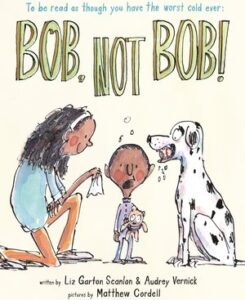 AV: At that point, it was just waiting for the right idea to come along, which happened when I got a cold and my Ms turned into Bs and we wrote Bob, Not Bob!. We recently received news of the sale of our fifth book together, though the deal has not yet been announced.
AV: At that point, it was just waiting for the right idea to come along, which happened when I got a cold and my Ms turned into Bs and we wrote Bob, Not Bob!. We recently received news of the sale of our fifth book together, though the deal has not yet been announced.
RVC: How are your collaborations with Liz different than those with your middle-grade novel partner, Olugbemisola Rhuday-Perkovich?
AV: At my core, I am more a picture-book writer than a novel writer. So I feel like my writing chops are better suited to the work I do with Liz. Thankfully, both women are remarkable and brilliant writers. (When choosing a writing partner, choose a brilliant writer. You’re welcome.)
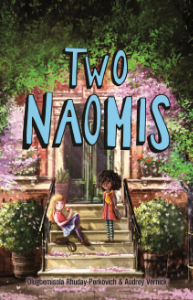 The process was very different. When writing Two Naomis and Naomis Too, Gbemi and I were alternating chapters, each writing from the point of view of a different character. If there was something in the other’s chapter we wanted to change/talk about, we’d indicate that with a comment in the margins of the document we sent back and forth. With Liz, we do not track changes and for the most part do not use comments. We back-and-forth the manuscript, and when it’s my turn, I treat it like it’s my manuscript—if I want to cut a line, I just do. If I want to reorder some lines, I do. And, of course, she does the same. And we VERY rarely go backwards to reincorporate something that’s been cut.
The process was very different. When writing Two Naomis and Naomis Too, Gbemi and I were alternating chapters, each writing from the point of view of a different character. If there was something in the other’s chapter we wanted to change/talk about, we’d indicate that with a comment in the margins of the document we sent back and forth. With Liz, we do not track changes and for the most part do not use comments. We back-and-forth the manuscript, and when it’s my turn, I treat it like it’s my manuscript—if I want to cut a line, I just do. If I want to reorder some lines, I do. And, of course, she does the same. And we VERY rarely go backwards to reincorporate something that’s been cut.
RVC: In all of your experience with collaboration, what has surprised you the most?
AV: The joy. The way that my cowriter can absolutely surprise and delight me with something I didn’t see coming. It’s a very improv way to write—very yes and.
RVC: What are a couple of key tips about being part of a successful writing collaboration?
AV: Begin with a kind, funny, wise collaborator. Make sure you’re on the same page—as in if one of you has strict ideas about how the collaboration will work and the other is more of a figure-it-out-as-we-go person, there might be some avoidable conflicts to work through.
It wouldn’t work for everyone, but I feel like Liz and I sort of stumbled into a system that works so well for us. One of us starts—maybe half a page, maybe less, and emails it to the other. We number each draft so one of us ends up with all even drafts, the other with odd. And we’re willing to admit when something isn’t working, sometimes trying again, and sometimes giving up.
With novels, we learned an interesting lesson on the Naomis books. The first book is about two separate characters whose lives come together (spoiler alert). The second is not. The two characters (whoops—even bigger spoiler alert) are now living in the same home. In hindsight—the reason winging it worked on the first book and didn’t on the second had to do with where the characters were. For the second book, we’d have been better served with some kind of loose outline at least. I am quite sure our editor would have thanked us for that.
RVC: You’re a huge baseball fan, and that comes through in your writing with such books as She Loved Baseball: The Effa Manley Story and All Star: How Larry Doby Smashed the Color Barrier in Baseball.
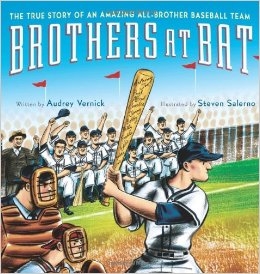 AV: Oh, baseball. November to February are such bleak months in the northeast and then add in no baseball and it can just make me weep. There’s a line in Brothers at Bat (warning, yes–I am about to quote myself) that says about the Acerra family, “Baseball set the rhythms of their life.” And I didn’t see it at the time, but it’s true of me too. When spring training starts, it’s such a relief.
AV: Oh, baseball. November to February are such bleak months in the northeast and then add in no baseball and it can just make me weep. There’s a line in Brothers at Bat (warning, yes–I am about to quote myself) that says about the Acerra family, “Baseball set the rhythms of their life.” And I didn’t see it at the time, but it’s true of me too. When spring training starts, it’s such a relief.
RVC: What’s the most difficult aspect of writing picture books about baseball?
AV: Finding a new story. Also, I really like to write about women in baseball, and so far I’ve only written and published two of those. There aren’t that many! One great thing is that people know this about me and so I receive links to interesting articles from everyone—people I went to elementary school with, other writers, distant relatives.
RVC: What’s your favorite baseball picture book?
AV: My favorites are the books that resonated for both me and my kids. My son, now a married adult, can still quote from Jonah Winter’s Fair Ball!: 14 Great Stars from Baseball’s Negro Leagues. And we were all really fond of Peter Golenbock’s Teammates.
RVC: One final question for this part of the interview. Brag time! What should we be looking for from you in the future?
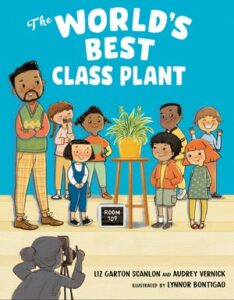 AV: Three collaborations with Liz! First up, and BRILLIANTLY illustrated by Lynnor Bontigao, The World’s Best Class Plant, from Putnam. After that, Homesick, illustrated by Daniel Miyares, a Neal Porter Book. And another not yet announced. Also, this just delights me—She Loved Baseball: The Effa Manley Story—which first published in 2010, will be available in paperback in January!
AV: Three collaborations with Liz! First up, and BRILLIANTLY illustrated by Lynnor Bontigao, The World’s Best Class Plant, from Putnam. After that, Homesick, illustrated by Daniel Miyares, a Neal Porter Book. And another not yet announced. Also, this just delights me—She Loved Baseball: The Effa Manley Story—which first published in 2010, will be available in paperback in January!
RVC: Okay, Audrey. It’s time for the SPEED ROUND! We’re looking for zippy-skippy questions followed by flappy-snappy answers. Are you ready to blast to the finish line?
AV: So ready!
RVC: What secret talent do you have that no one would expect?
AV: I can tell if someone is a Mets or Yankees fan, just by looking at them.
RVC: If you were a clown-themed superhero, what power(s) would you have?
AV: It would have something to do with being one of many tumbling out of a tiny car.
RVC: If you played professional baseball, what position would you play? And what would your nickname be?
AV: If I weren’t so short, I’d be thrown out into right field because of my skill level (no offense intended, AL MVP). My height would probably leave me in the middle infield but most likely I’d ride the bench. I haven’t yet had a nickname stick for the long haul.
Man, now I want a nickname.
RVC: What’s your most important good writing habit?
AV: Stubbornness—going back to the beginning and trying again when it’s not working.
RVC: Your favorite picture book of 2022?
AV: I cannot pick one. I can hone the list down to 112, but that is neither flappy nor snappy.
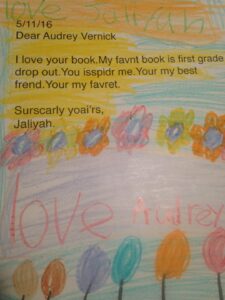 RVC: What’s the best thing a child has ever said about your writing?
RVC: What’s the best thing a child has ever said about your writing?
AV: My favorite letter from a kid is attached. It is the best thing ever said about anything ever.
RVC: Thanks so much, Audrey!
AV: Thank you!!


My takeaways were Audrey using voice to find her true north when writing a picture book, her stubbornness to always start over when the story does not feel right to her, and a copy of a letter from a precious child to remind us why we write picture books. Thank you so much!
I’m so glad you got a lot out of this interview, Henry. Thanks for spending some time here with us at OPB.